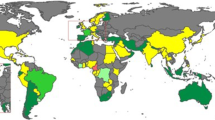Abstract
The contradiction between economic development, resources and environment is becoming more and more important every day. Based on the proposed energy conservation, this paper will study whether reducing energy consumption hinders economic growth. This article considers the spatial heterogeneity factors and the different energy consumption levels between different areas. Through empirical analysis, we discuss the quantitative relationship between energy consumption and economic growth from different areas. Finally, we propose long- and short-term strategic arrangements for energy consumption in order to facilitate sustainable development.

Similar content being viewed by others
References
Apergis, N., & Payne, J. E. (2009). Energy consumption and economic growth in Central America: evidence from a panel cointegration and error correction model. Energy Economics, 31(2), 211–216.
Asafu-Adjaye, J. (2000). The relationship between energy consumption, energy prices and economic growth: time series evidence from Asian developing countries. Energy Economics, 22(6), 615–625.
Barbosa, H. J. C., Lavor, C. C., & Raupp, F. M. P. (2005). A GA-simplex hybrid algorithm for global minimization of molecular potential energy functions. Annals of Operations Research, 138(1), 189–202.
Breitung, J. (2001). The local power of some unit root tests for panel data. In B. H. Baltagi, T. B. Fomby, & R. Carter Hill (Eds.), Nonstationary panels, panel cointegration, and dynamic panels. Advances in econometrics (Vol. 15, pp. 161–177). Emerald, Bingley.
Chang, C. C. (2010). A multivariate causality test of carbon dioxide emissions, energy consumption and economic growth in China. Applied Energy, 87(11), 3533–3537.
Cheng, B. S. (1997). Energy consumption and economic growth in Brazil, Mexico and Venezuela: a time series analysis. Applied Economics Letters, 4(11), 671–674.
Hadri, K., & Larsson, R. (2005). Testing for stationarity in heterogeneous panel data where the time dimension is finite. Econometrics Journal, 8(1), 55–69.
Hondroyiannis, G., Lolos, S., & Papapetrou, E. (2002). Energy consumption and economic growth: assessing the evidence from Greece. Energy Economics, 24(4), 319–336.
Im, K. S., Pesaran, M. H., & Shin, Y. (2003). Testing for unit roots in heterogeneous panels. Journal of Econometrics, 115(1), 53–74.
Kao, C. (1999). Spurious regression and residual-based tests for co-integration in panel data. Journal of Econometrics, 90(1), 1–44.
Lee, C. C., & Chang, C. P. (2007). The impact of energy consumption on economic growth: evidence from linear and nonlinear models in Taiwan. Energy, 32(12), 2282–2294.
Levin, A., Lin, C. F., & Chu, C. S. J. (2002). Unit root tests in panel data: asymptotic and finite-sample properties. Journal of Econometrics, 108(1), 1–24.
Li, F., Dong, S. C., Li, X., Liang, Q. X., & Yang, W. Z. (2011). Energy consumption-economic growth relationship and carbon dioxide emissions in China. Energy Policy, 39(2), 568–574.
Maddala, G. S., & Wu, S. W. (1999). A comparative study of unit root tests with panel data and a new simple test. In Oxford bulletin of economics and statistics in New Orleans, Louisiana. Blackwell, Oxford.
Oh, W., & Lee, K. (2004a). Causal relationship between energy consumption and GDP revisited: the case of Korea. Energy Economics, 26(1), 51–59.
Oh, W., & Lee, K. (2004b). Energy consumption and economic growth in Korea: testing the causality relation. Journal of Policy Modeling, 26(8–9), 973–981.
Tsani, S. Z. (2010). Energy consumption and economic growth: a causality analysis for Greece. Energy Economics, 32(3), 582–590.
Yu, E. S. H., & Jin, J. C. (1992). Co-integration tests of energy consumption, income, and employment. Resource and Energy Economics, 14(3), 259–266.
Yuana, J. H., Kang, J. G., Zhao, C. H., & Hu, Z. G. (2008). Energy consumption and economic growth: evidence from China at both aggregated and disaggregated levels. Energy Economics, 30(6), 3077–3094.
Author information
Authors and Affiliations
Corresponding author
Rights and permissions
About this article
Cite this article
Yang, L., Yang, T. Energy consumption and economic growth from perspective of spatial heterogeneity: statistical analysis based on variable coefficient model. Ann Oper Res 228, 151–161 (2015). https://doi.org/10.1007/s10479-012-1095-4
Published:
Issue Date:
DOI: https://doi.org/10.1007/s10479-012-1095-4




